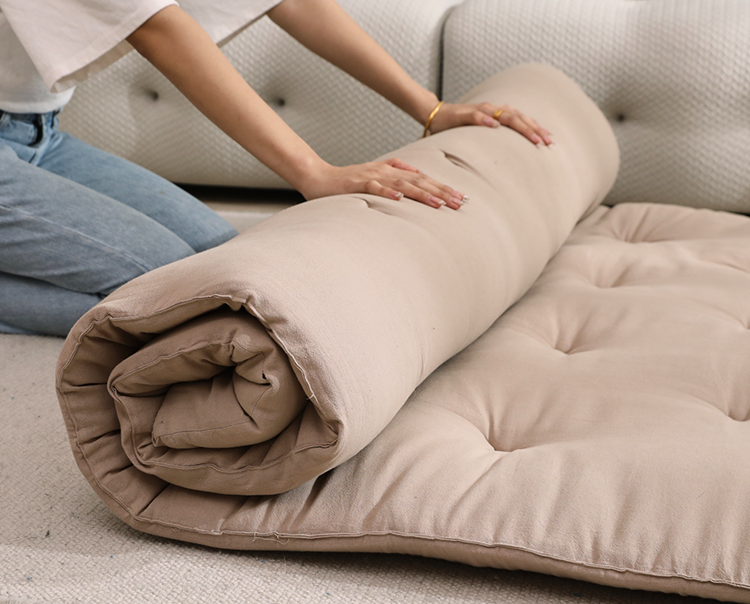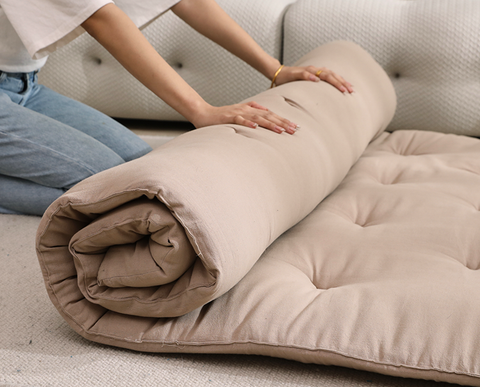It is no wonder that the futon has become a popular piece of furniture in recent years, as it offers a variety of unique benefits. A futon is a traditional Japanese bedding system comprised of padded mattresses and quilts that can be used as either a bed or couch. This versatility makes it an ideal choice for small spaces. In addition, a futon is lightweight and can be easily moved from room to room. Despite their obvious benefits, futons also come with a few drawbacks as well. In this article, we will take a look at the benefits, drawbacks, and how to properly use a futon.
What is a futon?
Futon is a traditional Japanese bedding system whose origin dates back to the 19th century. The term “futon” is a compound of words meaning to lie down or rest. It is comprised of padded mattresses and quilts that can be folded away during the day to create a couch-like seating area. The original futon was made from layers of fabric and cotton batting, stuffed with materials like rice straw.
Over time, the futon has evolved greatly. Today, futons are made with a variety of materials, including innerspring, latex, memory foam, and cotton. They are also available in a range of sizes and colors, making them more flexible and stylish than ever before. With its modern conveniences and versatile design, it is no wonder why the futon has become such a popular piece of furniture.
Benefits of futon
Cost-effective
Futons are relatively inexpensive compared to other types of furniture, making them a great choice for those on a budget. Not only are futons typically less expensive than traditional bed frames, but they are also much easier to clean and maintain.
Space-saving
One of the most obvious benefits of a futon is that it takes up minimal space, making it great for small homes or apartments. When not in use, futons can be folded away to create a couch-like seating area, offering maximum versatility in a small-space.
Lightweight
Futons are easy to move from room to room, and even easier to transport if needed. This is perfect for those who move often or live in a dormitory.
Stylish
Futons are now available in a variety of colors, sizes, and materials, making it easy to style them to match any living space. You can even customize futons with decorative pillows and throws to give it a more modern or traditional look.
Comfortable
Futons are incredibly comfortable, providing the perfect blend of mattress technology and cushioning for optimal support. The mattress itself is usually designed with layers of different materials to ensure maximum comfort.
Drawbacks of futon

Limited durability
Futons are not known for lasting a long time due to their lightweight construction and low-quality materials. If not taken care of properly, a futon can quickly lose its shape and become uncomfortable.
Not structurally sound
Futons do not provide the same level of stability and support as a traditional bed frame, making them unsuitable for those who need extra back or neck support.
Prone to becoming sagging
Over time, futons are prone to becoming sagging in the middle because of the continuous weight placed on the mattress. If not rotated regularly, a futon can experience saggy spots or permanent dings.
How to use a futon?
Map out your space
Before you can bring a futon into your space, you need to map it out. Measure your available floor space and any obstacles that might prevent you from properly placing a futon in a convenient spot. Make sure you have enough space to comfortably maneuver around the futon even when it is in use.
Choosing the best size & style
Next, you will want to find the perfect fit for your space in terms of size and style. There are a variety of futon styles and sizes to choose from, so make sure you take your time and find one that works for your individual needs.
Preparing the futon for use
Before you can use a futon as a bed or couch, you will need to prepare it for use. This includes securely fastening the mattress and base, as well as organizing any decorative pillows or throws.
Storing a futon
To store a futon, simply fold it up and place it in a dry, safe area, such as a closet or storage room. Make sure it is away from direct sunlight and other forms of damage. You should also consider investing in a protective cover to help keep your futon in top condition.
Maintaining& caring a futon
To keep your futon in top condition, you will need to clean and maintain it regularly. Vacuum it regularly to get rid of dust and debris. It is also important to flip or rotate your futon every few weeks to help prevent the formation of dents or sagging. Finally, make sure to spot clean any spills or marks on the mattress as soon as they occur.
Knowing when to replace a futon
Eventually, your futon will lose its shape and become uncomfortable. If this happens, it is time to replace it with a new one. This is the best way to ensure you get the most out of your futon and keep it looking its best.
Conclusion
In conclusion, a futon can be a great solution for those looking for comfort and convenience, while also being mindful of their budget and space. With the right care and maintenance, a futon can provide years of comfort and support. Be sure to speak to a medical professional to determine which type of futon is best for your individual needs and lifestyle.



